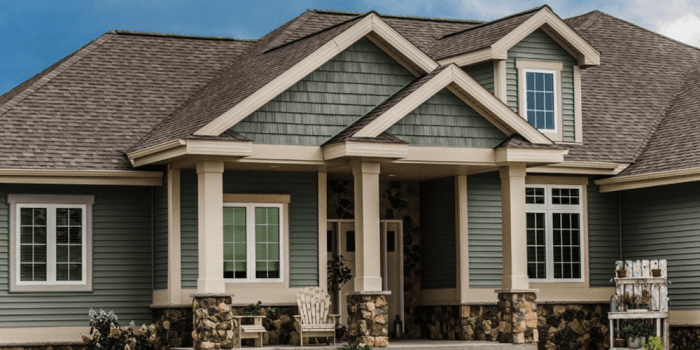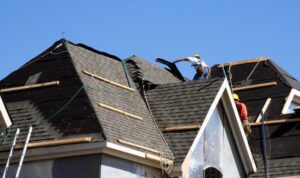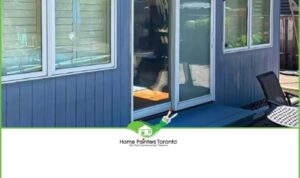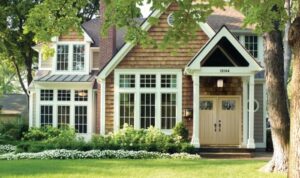When it comes to finding the perfect siding for your home, the options can be overwhelming. From vinyl to wood to fiber cement, each material has its own set of benefits and considerations. In this comprehensive guide, we will explore the different types of siding materials, factors to consider when choosing siding, cost comparisons, and the environmental impact of your choices.
Get ready to transform your home with the best siding options available!
Types of Siding Materials

When it comes to choosing siding for your home, there are several materials to consider. Each material has its own set of characteristics, advantages, and maintenance requirements. Let's take a closer look at the most common types of siding materials available:
Vinyl Siding
Vinyl siding is a popular choice for many homeowners due to its affordability and low maintenance requirements. It is durable, resistant to rot and insect damage, and comes in a wide range of colors and styles. However, vinyl siding can crack or fade over time, especially in extreme weather conditions.
Wood Siding
Wood siding offers a natural and timeless look to a home. It can be painted or stained in various colors to match your preferences. While wood siding is aesthetically pleasing, it requires regular maintenance such as painting, staining, and sealing to prevent rot, mold, and insect infestations.
Fiber Cement Siding
Fiber cement siding is a durable and low-maintenance option that mimics the look of wood or masonry. It is resistant to fire, rot, and pests, making it a popular choice for many homeowners. However, fiber cement siding can be more expensive than vinyl or wood siding, and it may require professional installation.
Metal Siding
Metal siding, such as aluminum or steel, is known for its durability and longevity. It is resistant to fire, rot, and pests, making it a practical choice for areas with harsh weather conditions. Metal siding is available in a variety of colors and styles, but it may dent or scratch easily.Overall, the choice of siding material for your home will depend on factors such as budget, maintenance preferences, and desired aesthetic.
Consider the durability, maintenance requirements, and cost of each type of siding material before making a decision.
Factors to Consider When Choosing Siding
Choosing the right siding for your home involves considering several important factors that can impact both the aesthetics and functionality of your property.
Importance of Climate Consideration
When selecting siding for your home, it is crucial to take into account the climate of your region. Different siding materials have varying levels of durability and resistance to weather elements. For example, vinyl siding is a popular choice in areas with high moisture levels due to its resistance to rot and mold.
On the other hand, fiber cement siding is known for its durability in extreme weather conditions. By choosing siding that is suitable for your climate, you can ensure that your home remains protected and maintains its appearance over time.
Impact on Energy Efficiency
The type of siding you choose can also have a significant impact on the energy efficiency of your home. Insulated siding, for instance, can help reduce heat loss during the winter months and keep your home cooler in the summer, leading to lower energy bills.
Additionally, siding materials with high thermal resistance can contribute to maintaining a comfortable indoor temperature year-round. Considering the energy efficiency of your siding choice can not only save you money in the long run but also reduce your environmental impact.
Aesthetic Aspects to Consider
In addition to functionality, the aesthetic appeal of your siding should also be taken into consideration. The color, texture, and style of the siding can greatly impact the overall look of your home. Whether you prefer a modern, sleek appearance or a more traditional and cozy feel, there are various siding options available to suit your aesthetic preferences.
It is essential to choose a siding material that complements the architectural style of your home and enhances its curb appeal.
Cost Comparison of Siding Options
When it comes to choosing the right siding for your home, cost is a significant factor to consider. The initial investment and long-term maintenance costs can vary depending on the material you choose. Let's break down the costs and compare the different siding options available.
Vinyl Siding
Vinyl siding is one of the most affordable options on the market
Fiber Cement Siding
Fiber cement siding is a bit pricier upfront compared to vinyl, but it offers excellent durability and requires minimal maintenance over the years. The initial investment may be higher, but the long-term cost savings in terms of maintenance and repairs can make it a cost-effective choice.
Wood Siding
Wood siding provides a natural and timeless look to homes, but it comes with a higher initial cost. The material itself is more expensive, and wood siding requires regular maintenance, such as painting or staining, to prevent rot and decay.
While the upfront cost may be higher, the long-term maintenance expenses should be factored in.
Aluminum Siding
Aluminum siding is another cost-effective option with a moderate upfront cost. It is durable and low maintenance, making it a popular choice for many homeowners. While aluminum siding may dent or fade over time, it generally requires minimal upkeep, reducing long-term costs.
Comparing the Costs
In summary, vinyl siding is the most budget-friendly option, both in terms of material cost and installation. Fiber cement siding may have a higher initial investment, but its durability and low maintenance can lead to cost savings in the long run.
Wood siding, while aesthetically pleasing, comes with higher maintenance costs over time. Aluminum siding falls in the middle in terms of cost, offering durability and low maintenance at a moderate price point.Consider your budget and long-term maintenance preferences when choosing the right siding for your home.
Environmental Impact of Siding Choices
When choosing siding for your home, it's important to consider the environmental impact of the materials you're using. Different siding options have varying levels of sustainability, recyclability, and eco-friendliness.
Sustainability of Different Siding Materials
Some siding materials are more sustainable than others. For example, wood siding sourced from responsibly managed forests can be a renewable and sustainable option. On the other hand, vinyl siding, while durable, is made from non-renewable resources like PVC.
Recyclability and Eco-friendliness of Popular Siding Choices
- Fiber cement siding: Made from a combination of cement, sand, and cellulose fibers, fiber cement siding is highly durable and can be recycled at the end of its lifespan, making it an eco-friendly option.
- Wood siding: While wood siding can be biodegradable, it requires maintenance and treatments that may not be environmentally friendly. However, it can be recycled or repurposed if taken care of properly.
- Aluminum siding: Aluminum siding is recyclable and has a long lifespan, making it a sustainable choice. However, the manufacturing process can have a higher carbon footprint compared to other materials.
Carbon Footprint Associated with Manufacturing and Installing Different Siding Materials
The manufacturing and installation of siding materials can have a significant impact on the environment. For example, vinyl siding production releases harmful chemicals into the environment, contributing to air and water pollution. On the other hand, fiber cement siding manufacturing may require less energy and produce fewer emissions.
Closing Summary
As we wrap up our exploration of the best siding for homes, it's clear that making the right choice can enhance not only the aesthetic appeal of your home but also its durability and eco-friendliness. By considering factors like climate, energy efficiency, and long-term costs, you can make an informed decision that will benefit you and the environment.
Choose wisely and enjoy the benefits of high-quality siding for years to come.
Quick FAQs
What is the most durable siding material?
Vinyl siding is known for its durability and low maintenance requirements, making it a popular choice for many homeowners.
How does climate impact the choice of siding?
Climate plays a crucial role in determining the best siding for your home. For example, in areas with high humidity, fiber cement siding may be a better choice due to its resistance to moisture.
Are metal sidings eco-friendly?
Metal sidings are often considered eco-friendly as they can be recycled and have a long lifespan, reducing the need for frequent replacements.









